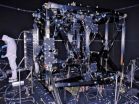(Press-News.org) (Boston) - Researchers from Boston Medical Center (BMC) and Boston University School of Public Health (BUSPH) have found that individuals who do not speak English at home are less likely to receive colorectal cancer screenings (CRC) as compared to those who do speak English at home. The findings, which currently appear on-line in the Journal of General Internal Medicine, suggest that patient-provider language barriers play a role in health-care disparities, and that providers should promote the importance of CRC screening to non-English speaking patients.
The United States has tremendous ethnic and linguistic diversity. According to the 2005� American Community Survey, minorities comprise 26 percent of the population, and nearly 20 percent of Americans speak a language other than English at home. By 2050, it is projected that minorities will comprise about half of the US population, with a similar increase in individuals speaking a language other than English at home.
The researchers performed a retrospective study of individuals age 50 years and older who were categorized as English-concordant (spoke English at home); other Language-Concordant (did not speak English at home but someone at their provider's office spoke their language); or other Language-Discordant (did not speak English at home and no one at their provider's spoke their language). Compared to English speakers, non-English speakers had lower rates of CRC screening. Compared to the English-Concordant group, the Other Language-Discordant group had similar screening levels, while the Other Language-Concordant group had lower screening levels.
"Our initial findings are consistent with other reports. However, in our adjusted model, we found that those who did not speak English at home but who had someone at their provider's office who spoke their preferred language, had the lowest rate of CRC screening and this was unexpected," said lead author Amy Linsky, MD, a fellow in general internal medicine at BMC.
"Our results suggest that providers should especially promote the importance of CRC
screenings to non-English speaking patients, but that patient-provider language barriers do not fully account for lower CRC screening in patients who do not speak English at home," added co-investigator Nathalie McIntosh, a doctoral student in health Policy and Management at BUSPH.
According to the researchers, these findings may be related to unmeasured differences between the two cohorts, including patient characteristics, provider cultural competence, patient acculturation, the quality of patient-provider communication, and the level of patient health literacy including obtaining colorectal cancer screening. "Professional interpreters and language-concordant providers may be necessary, but not sufficient to mitigate these disparities," added Linsky.
INFORMATION: END
Study finds language barriers may play role in health care disparities
2010-09-29
ELSE PRESS RELEASES FROM THIS DATE:
Predicting divorce: U-M study shows how fight styles affect marriage
2010-09-29
AUDIO:
A new University of Michigan study shows how fight styles affect marriage.
Click here for more information.
ANN ARBOR, Mich.---It's common knowledge that newlyweds who yell or call each other names have a higher chance of getting divorced. But a new University of Michigan study shows that other conflict patterns also predict divorce.
A particularly toxic pattern is when one spouse deals with conflict constructively, by calmly discussing the situation, listening to their ...
Leading practitioners recommend global PTSD treatment guidelines
2010-09-29
Melbourne, Australia—September 28, 2010— In recent years, several guidelines in the treatment of posttraumatic stress disorder have been put into practice globally. Practice guidelines across the health sphere are very important in guiding the care people receive. Although there is a high level of consensus on these guidelines among practitioners, there are also differences that can lead to confusion among providers, patients, and purchasers of mental health services for people affected by trauma. A new article in the Journal of Traumatic Stress written by the international ...
Market changes affect risk tolerance, MU study finds
2010-09-29
COLUMBIA, Mo. – As the U.S. economy continues to lag, many investors remain wary about taking risks with the stock market. Now, researchers at MU have concluded that this attitude toward investment risk-taking is more than just a recent trend. Rui Yao, a University of Missouri assistant professor in the Personal Financial Planning department in the College of Human Environmental Sciences, has found that during the past two decades, the risk tolerance of investors is positively correlated to the movements of the stock market, meaning that investors are likely to invest more ...
NASA sees colder cloud-top temps in new Tropical Depression 16, warnings up
2010-09-29
NASA's Aqua satellite has peered into the cloud tops of System 96L in the western Caribbean early this morning and noticed that they've become colder and higher, which indicated the storms was strengthening and organizing. Just over eight hours later, the new Tropical Depression 16 was born, and now has the potential to become a tropical storm before it merges with an elongated area of low pressure near the Florida late on Wednesday.
Tropical Depression 16 was officially named this morning, Sept. 28 at 11 a.m. EDT by NOAA's National Hurricane Center in Miami, Fla. Many ...
Goddard team obtains the 'unobtainium' for NASA's next space observatory
2010-09-29
Imagine building a car chassis without a blueprint or even a list of recommended construction materials.
In a sense, that's precisely what a team of engineers at the NASA Goddard Space Flight Center in Greenbelt, Md., did when they designed a one-of-a-kind structure that is one of 9 key new technology systems of the Integrated Science Instrument Module (ISIM). Just as a chassis supports the engine and other components in a car, the ISIM will hold four highly sensitive instruments, electronics, and other shared instrument systems flying on the James Webb Space Telescope, ...
NASA's Webb Telescope unique structural 'heart' passes extreme tests
2010-09-29
GREENBELT, Md. -- NASA engineers have created a unique engineering marvel called the ISIM structure that recently survived exposure to extreme cryogenic temperatures, proving that the structure will remain stable when exposed to the harsh environment of space. The material that comprises the structure, as well as the bonding techniques used to join its roughly 900 structural components, were all created from scratch.
The ISIM, or the Integrated Science Instrument Module Flight Structure, will serve as the structural "heart" of the James Webb Space Telescope. The ISIM ...
Employee wellness plans should include entire company, not just sick workers
2010-09-29
ANN ARBOR, Mich.---A study of employees at a west Michigan hospital showed some of the most unhealthy workers that University of Michigan researchers had ever seen.
But in four years, the workplace wellness plan at Allegiance Health in Jackson, Mich. had fueled some of the biggest improvements in employee health that those same researchers had ever witnessed.
The researchers were studying the hospital system to evaluate the health risk changes in employees in the four years after Allegiance implemented a workplace wellness program. The "It's Your Life" program was ...
Tiny generators turn waste heat into power
2010-09-29
Washington, D.C. (September 28, 2010) -- The second law of thermodynamics is a big hit with the beret-wearing college crowd because of its implicit existential crunch. The tendency of a closed systems to become increasingly disordered if no energy is added or removed is a popular, if not depressing, "things fall apart" sort-of-law that would seem to confirm the adolescent experience.
Now a joint team of Ukrainian and American scientists has demanded more work and less poetry from the second law of thermodynamics, proposing a novel "pyroelectric" method to power tiny ...
New device for identifying aggressive breast cancers
2010-09-29
Washington, D.C. (September 28, 2010) -- A new disposable device based on advances in microfluidics may help identify advanced breast cancer patients who are candidates for therapy with the drug trastuzumab (Herceptin). The device is described in the American Institute of Physics' journal Biomicrofluidics.
Aggressive breast cancers with poor prognosis typically have abnormal levels of the protein HER2 (the tyrosine kinase human epidermal growth factor receptor 2). The new elastomeric, rubber-like device is designed to efficiently capture cancer cells overexpressing HER2 ...
Finding a buckyball in photovoltaic cell
2010-09-29
Washington, D.C. (September 28, 2010) -- Polymer-based photovoltaic cells have some real advantages compared to the currently used semiconductor-based cells. They are easy to make and the materials are cheap. The challenge is to figure out how to make efficient cells while keeping the manufacturing cost low.
One approach uses a light-absorbing polymer along with a derivative of a sixty-carbon fullerene molecule, commonly known as a buckyball. For maximum efficiency, the two materials must be present in thin layers near opposite electrodes but most analytical methods ...

